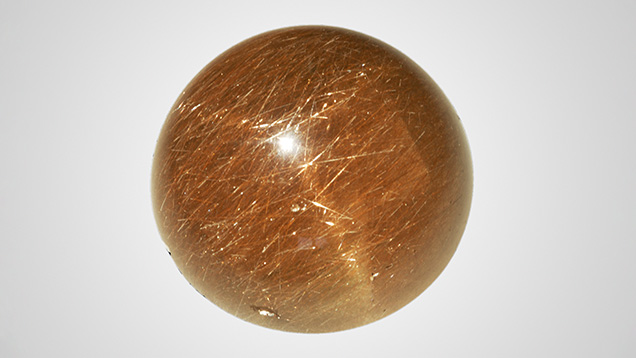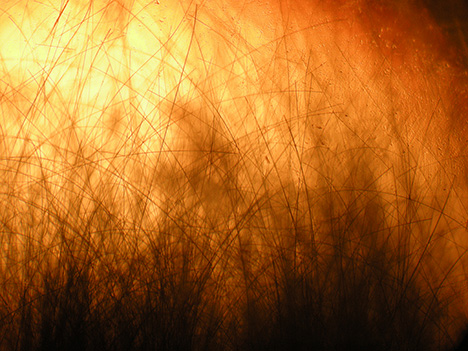Three-Rayed Asterism in Quartz

Asterism is a well-known (if not the most familiar) optical phenomenon observed in numerous gem species. In transparent or translucent gemstones, a series of parallel inclusions consisting of tiny needles or channels produces a distinct light band by a complex process of scattering and reflection of light. If the gemstone is cut as a cabochon, the light band, which is oriented perpendicular to the needle or channel axis, generally produces a sharp light line on the surface of the gemstone, an effect known as chatoyancy. If several series of parallel inclusions are present, we observe several intersecting light bands producing asterism. The number of rays in a star depends on the number of intersecting light bands. For example, two intersecting light bands produce four-rayed stars, three intersecting light bands produce six-rayed stars, and so on.
A single star is observed if all needles or channels are oriented parallel to a single plane. If the inclusions are found in different planes, we might observe several stars on the surface of a cabochon or sphere (K. Schmetzer et al., “Dual-color double stars in ruby, sapphire, and quartz: Cause and historical account,” Summer 2015 G&G, pp. 112–143). This effect can be due to the symmetry of the host, which causes several series of non-planar needles (e.g., in cubic spinel or garnet). Multi-asterism is also produced by several series of needles that are independent of each other, as in quartz or beryl (K. Schmetzer and M. Glas, “Multi-star quartzes from Sri Lanka,” Journal of Gemmology, Vol. 28, No. 6, 2003, pp. 321–332). A combination of these two variants is observed in garnet. All different variants may be designated as a “network of stars.”
The present contribution describes three-rayed asterism, a phenomenon that does not really fit into the generally accepted knowledge about the formation of asterism and multi-asterism. This variant of asterism in quartz is a rare optical phenomenon mentioned briefly by Gübelin and Koivula (Photoatlas of Inclusions in Gemstones, Volume 2, 2005, Opinio-Verlag, Basel, Switzerland, p. 548) and by Steinbach (Asterism: Gems with a Star, 2016, MPS Publishing and Media, Idar-Oberstein, Germany, pp. 649–651). Hainschwang (Fall 2007 GNI, pp. 261–262) observed two three-rayed stars on quartz cabochons with chlorite inclusions. The two stars had one ray in common and were observed upon rotation of the cabochon, with one of the three-rayed stars observed at another end of the ray that is shared by both stars. Hainschwang assumed that the optical phenomenon was caused by the chlorite inclusions, but the formation mechanism is not completely understood.

Our observation is based on the examination of four star quartz samples, which came from the private collection of one of the authors (MPS). The quartz cabochons were purchased at various gem and mineral fairs and were said by the vendors to originate from Brazil; further details on locality are unknown. The properties of the cabochons are summarized in table 1.
Upon first view, the samples showed broad light bands forming a three-rayed star, with all branches of the star originating from a center (figure 1). The single branches of the three-rayed stars move along the surface of the cabochons after rotation of the stone or a change of the position of the light source or the observer. So far, this observation is consistent with the features of light bands generally observed in asteriated gemstones. But in “normal” gemstones (e.g., star rubies or star sapphires), we see three intersecting light bands forming a six-rayed star.

Surprisingly, upon rotation of the cabochons it was detected that the samples did not show a single three-rayed star but a multi-star network. Rotating each quartz cabochon in a direction in which it was possible to follow one of the light bands on the cabochon’s surface, at some point this branch of the star ended in another center of a three-rayed star. Repeating this procedure, another center of a three-rayed star was occasionally detected, unless the branches of the three-rayed star ended at the girdle (figure 2).

Figure 3 shows a schematic representation of the multi-star networks observed in the four samples. It must be underscored that the different patterns drawn represent lines on curved domes of the different cabochons. If the branches of the stars are in a position close to the girdle, some lines that appear almost straight in the middle of the cabochon will appear more or less curved. So far, due to the different orientations of the cabochons and the different shapes, each sample represents only part of a full star network that would be seen on the surface of a complete sphere.

All the samples revealed a dense pattern of needle-like to fibrous inclusions (figure 4) typically described as rutile (J. Hyršl and G. Niedermayr, Magic World: Inclusions in Quartz, 2003, Bode Verlag, Haltern, Germany, pp. 82–139). However, these inclusions are mostly bent or curved, and no series of parallel needles or channels were seen under the magnification of a gemological microscope (up to 100×). It is uncertain how these curved rutile inclusions, sometimes described as “fibers” or “hairs,” contribute to the phenomenal pattern observed.
The mechanism responsible for the observed multi-star network is unknown; it could be caused by structural features or inclusions. However, quartzes with similar rutile inclusion patterns from Brazil (as shown in figure 4) and elsewhere generally do not show three-rayed asterism or the type of three-rayed asterism network described here. It is possible to create a single three-dimensional network by a combination of the variants seen in figure 3, A–D. But this would be highly speculative, since we cannot (based on the samples available) prove that all variants seen so far contribute to one single pattern.



